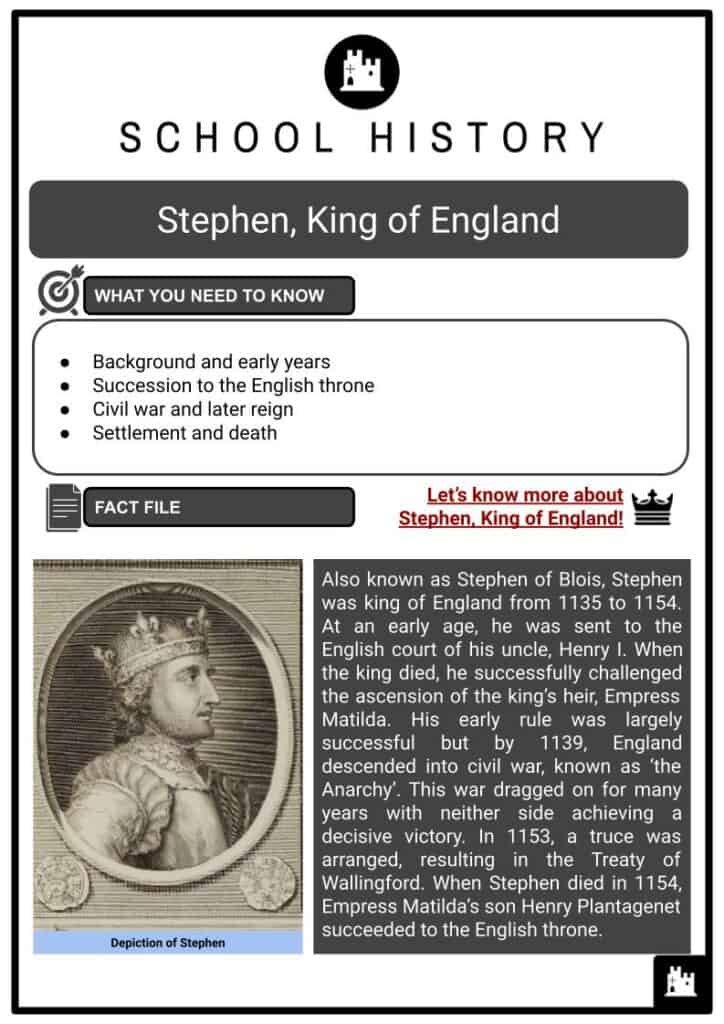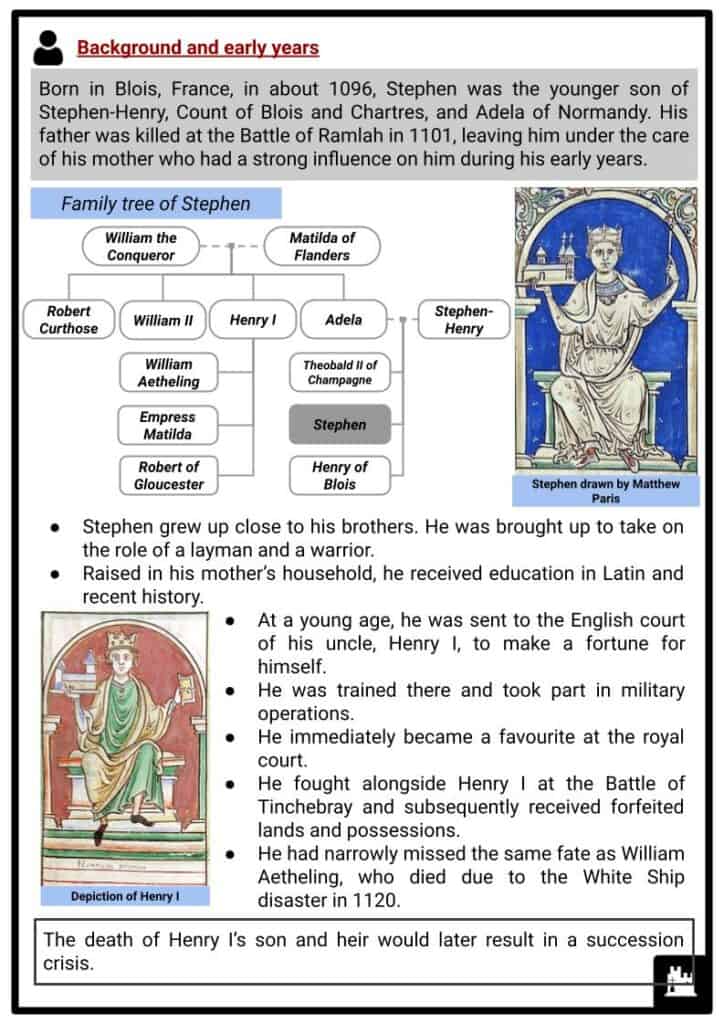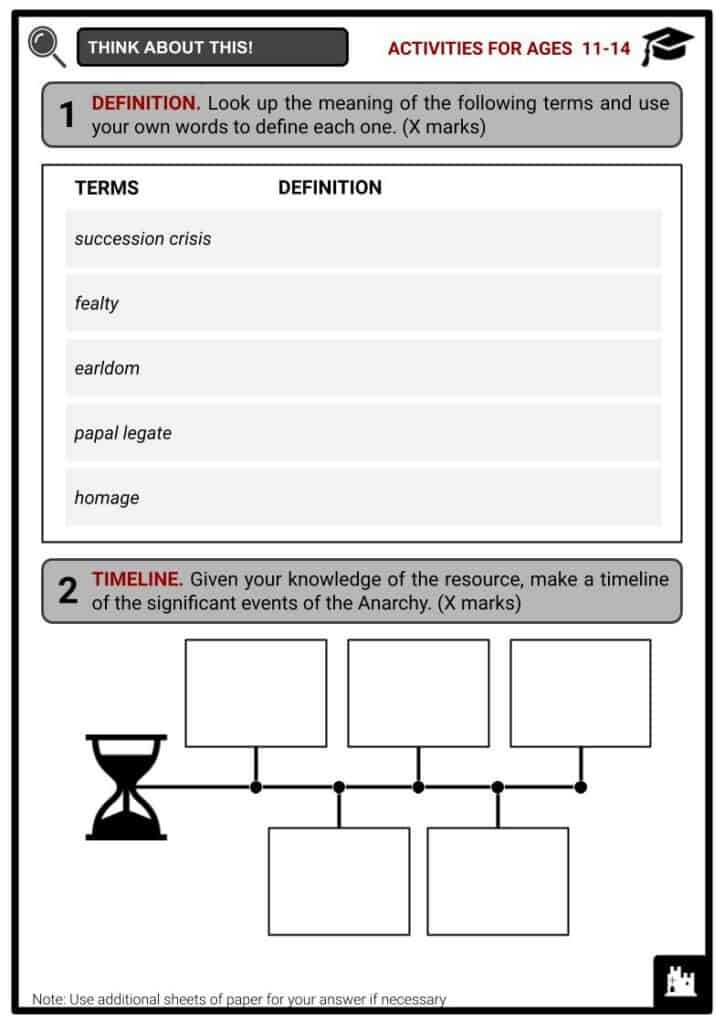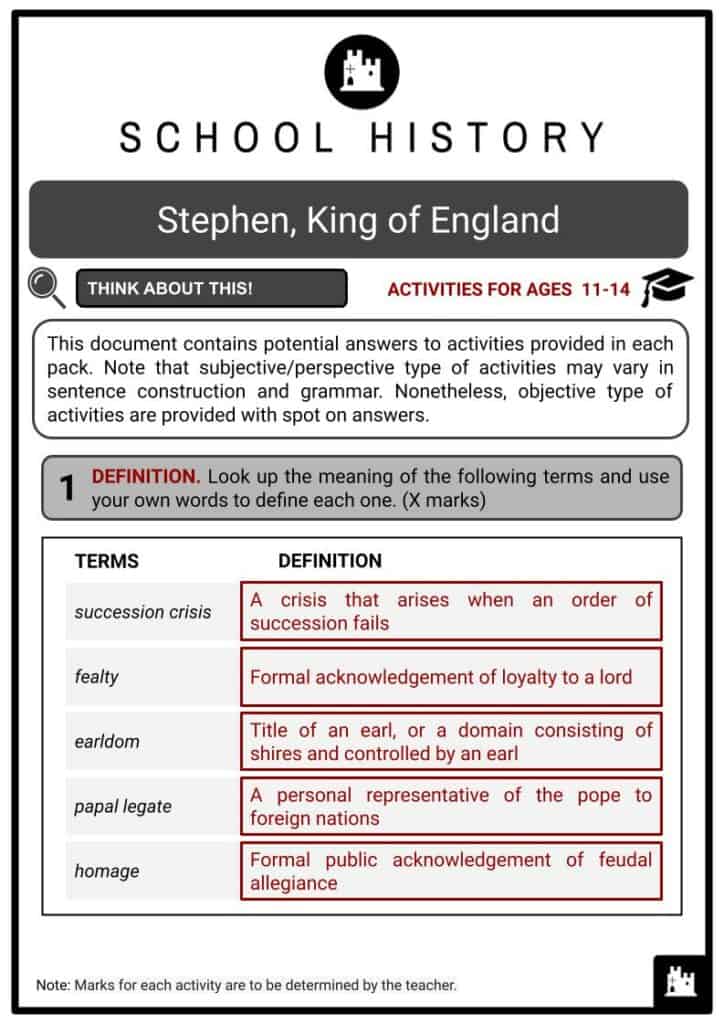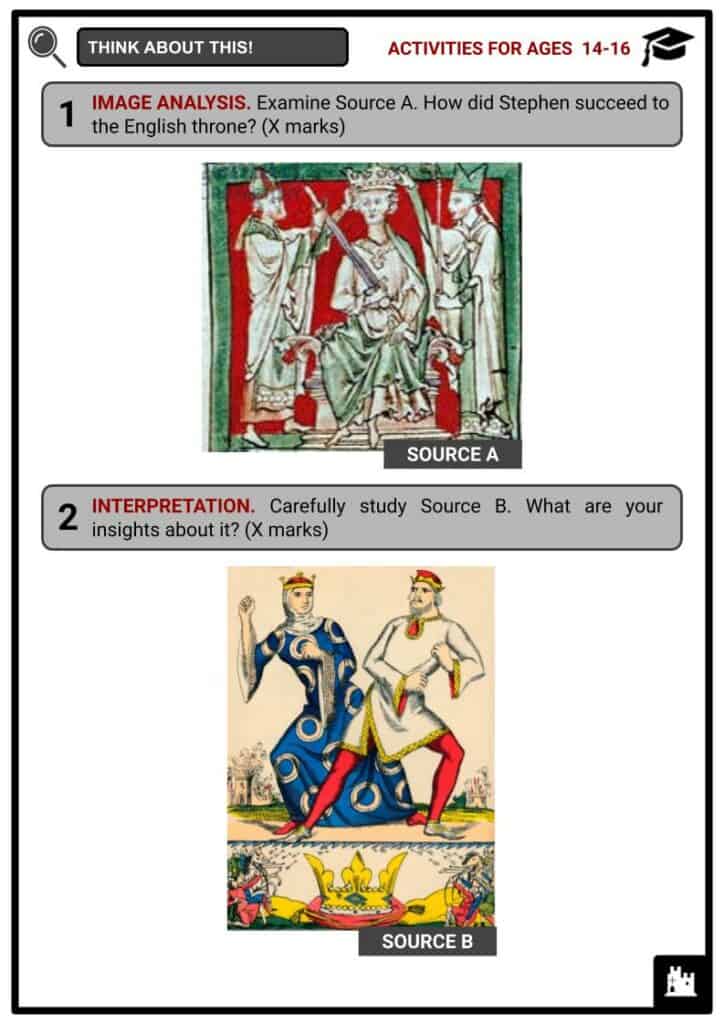Download Stephen, King of England Worksheets
Do you want to save dozens of hours in time? Get your evenings and weekends back? Be able to teach about Stephen, King of England to your students?
Our worksheet bundle includes a fact file and printable worksheets and student activities. Perfect for both the classroom and homeschooling!
Summary
- Background and early years
- Succession to the English throne
- Civil war and later reign
- Settlement and death
Key Facts And Information
Let’s know more about Stephen, King of England!
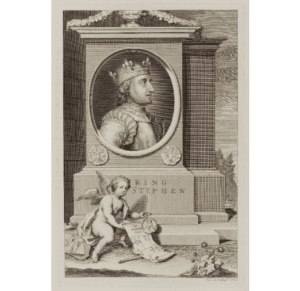
Also known as Stephen of Blois, Stephen was king of England from 1135 to 1154. At an early age, he was sent to the English court of his uncle, Henry I. When the king died, he successfully challenged the ascension of the king’s heir, Empress Matilda. His early rule was largely successful, but by 1139, England descended into civil war, known as ‘the Anarchy’. This war dragged on for many years with neither side achieving a decisive victory. In 1153, a truce was arranged, resulting in the Treaty of Wallingford. When Stephen died in 1154, Empress Matilda’s son Henry Plantagenet succeeded to the English throne.
Background and early years
- Born in Blois, France, in about 1096, Stephen was the younger son of Stephen-Henry, Count of Blois and Chartres, and Adela of Normandy. His father was killed at the Battle of Ramlah in 1101, leaving him under the care of his mother who had a strong influence on him during his early years.
- Stephen grew up close to his brothers. He was brought up to take on the role of a layman and a warrior.
- Raised in his mother’s household, he received education in Latin and recent history.

- At a young age, he was sent to the English court of his uncle, Henry I, to make a fortune for himself.
- He was trained there and took part in military operations.
- He immediately became a favourite at the royal court.
- He fought alongside Henry I at the Battle of Tinchebray and subsequently received forfeited lands and possessions.
- He had narrowly missed the same fate as William Aetheling, who died due to the White Ship disaster in 1120.
- The death of Henry I’s son and heir would later result in a succession crisis.
Succession to the English throne
- Following the death of William Aetheling, Henry I named his remaining legitimate child, Matilda, now Holy Roman Empress, as his successor. When the king died in 1135, Empress Matilda was in Anjou and Stephen, who was in Boulogne, quickly left for England with his military household.
- Having gathered enough baronial support and secured the royal treasury, Stephen was crowned king of England on 22 December 1135.
- His younger brother, Henry of Blois, ensured the support of the Church to him while his older brother, Theobald, who was thought to have the most valid claim over the kingdom and the duchy, was forced to accept his succession.
- Immediately after his coronation, the new king had to intervene in the Scottish invasion by David I of Scotland in the north of England.
- David I sought to take Cumberland and Northumbria, and his army was met by Stephen and his men at Durham.
- David I was effectively bought off by Stephen’s agreeing that David I’s son Henry should receive Carlisle, Doncaster and the earldom of Huntingdon.
- Stephen held his first royal court, attended by a wide range of nobles, at Westminster at Easter 1136.
- His accession was confirmed by Pope Innocent II by letter later that year.
- Despite having demonstrated his legitimacy, the reign of Stephen was afflicted by unrest.
- Across the English Channel, Normandy was invaded by Empress Matilda’s second husband, Geoffrey Plantagenet, Count of Anjou, in 1136.
- Unable to travel to the duchy, Stephen left its defence in the hands of his close adviser, Waleran de Beaumont, and Theobald.
- A deal was negotiated in 1137, under which Louis VI of France recognised Stephen’s son, Eustace, as Duke of Normandy in exchange for Eustace giving fealty to the French king.
- That same year, rebellion broke out in south Wales, with considerable territories captured by the Welsh.
- In response, Stephen sent his men to pacify the region, but this was unsuccessful.
- By the end of the year, the king appeared to have abandoned attempts to suppress the uprisings in south Wales to focus on his other problems.
Civil war and later reign
-

Empress Matilda Whilst Stephen appeared to have successfully claimed the throne by usurpation, the matter of inheritance of the English throne was not fully settled. Empress Matilda wanted the crown that she was promised. The Angevin invasion of England was supported by her ambitious husband Count Geoffrey, her illegitimate half-brother, Robert of Gloucester, and her uncle, David I of Scotland.
- From 1139, England descended into civil war, known as ‘the Anarchy’.
- Empress Matilda and Robert of Gloucester arrived in England and established themselves in the southwest whilst Stephen’s power base lay in the east.
- Local feuds were pursued during the civil war, leading to the breakdown of the bond between the king and the nobles and senior figures.
Timeline of the Anarchy
- Empress Matilda landed at Arundel Castle in 1139. Stephen besieged the castle, trapping his rival inside. Possibly persuaded by Henry of Blois to release the empress and to concentrate on attacking Robert of Gloucester, the king agreed to a truce.
- Rebellions also broke out in East Anglia led by Nigel, Bishop of Ely, and in the north, headed by Ranulf of Chester. Order was temporarily restored in the east. Ranulf escaped Lincoln Castle and proclaimed his support for Empress Matilda. Stephen would fight him in the Battle of Lincoln in 1141.
- At the Battle of Lincoln, the forces of Robert of Gloucester and Ranulf turned out to be superior to Stephen’s army. Stephen was captured and imprisoned for nearly nine months, during which he was poorly treated.
- Empress Matilda took this chance to establish herself as the queen of England. However, her arrogance was soon hated by her supporters and the English people whilst Stephen remained popular. The clergy declared the empress ‘Lady of England and Normandy’ as a precursor to her coronation. Advancing to London to stage her coronation, Empress Matilda faced an uprising by Stephen’s supporters and was forced to flee to Oxford, uncrowned.
- That same year, Robert of Gloucester was captured by Stephen’s wife, Matilda of Boulogne, with the aid of loyal nobles and Flemish mercenaries. Stephen was exchanged for Robert, weakening the position of Empress Matilda. A fresh coronation of Stephen and Matilda occurred at Christmas 1141. Stephen then besieged the castle in Oxford, where his rival was based. Empress Matilda fled to Abingdon Abbey and then Wallingford Castle.
- In 1143, Robert of Gloucester besieged Wilton Castle, where Stephen was staying. This led to the Battle of Wilton, in which Stephen was almost caught for a second time. With the fierce rear guard effort of Stephen’s steward, the king was able to escape from the battlefield.
- Stephen also faced threats in other parts of his domain. Geoffrey de Mandeville, Earl of Essex, rose up in rebellion against him in East Anglia in late 1143 until 1144. Ranulf of Chester revolted in the north in the summer of 1144. Robert of Gloucester and his followers continued to raid the surrounding royalist territories in the west. By 1147, England had suffered extensively from this period of conflict.
- The death of Robert of Gloucester in 1147 wore out Empress Matilda’s forces. She retired to Normandy afterwards and her son, Henry Plantagenet, took up the mantle of claiming the English throne.
-
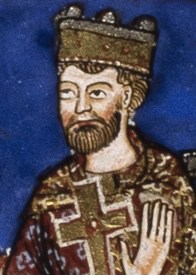
Henry Plantagenet In the late 1140s, Henry Plantagenet attempted to invade England twice. Although these campaigns failed, he was increasingly gaining a reputation as a capable leader. Meanwhile, Stephen started to focus on the issue of his family and the succession. Henry Plantagenet’s victory in England came in 1153, in which he managed to take control of much of the country with little fighting. Stephen and Henry began peace negotiations soon after, bringing an end to the Anarchy.
- During the civil war, many areas of the kingdom saw little military violence, but people within these relatively peaceful areas possibly experienced constraint and threat.
- Despite being called the anarchy, the conflict during the period did not lead to the dissolution of the social and political order.
- In fact, the participants of the war were often willing to resort to peaceful solutions instead of violence.
- Stephen was able to carry on fighting even after his release from captivity and despite the financial difficulties early in his reign.
- His needs were supported by the royal finance, which was raised through various means:
- The king created earldoms to check the loyalty of the sheriffs and to oversee the revenues.
- The king called for assistance from wealthy clerics and the monasteries, voluntary donations or loans.
- The king collected taxes from the counties under his control.
- The king looked to urban wealth, including that of Winchester, York and London, to fund the wars.
- During the period of anarchy, the institutions of government did not disappear altogether.
- However, only the southeast and London, the power base of the king, had access to justice, especially in the 1140s.
- With Stephen’s government losing control of much of England, many earls and barons switched sides during the civil war.
- Stephen’s relationship with the Church also suffered during his reign.
- During his first years as king, the Church was supportive of his rule.
- In fact, he agreed to allow extensive freedoms and liberties to the Church, and grant his brother, Henry of Blois, Bishop of Winchester, the archbishopric of Canterbury.
- Furthermore, Stephen’s encouragement to the monastic orders to form abbeys on his estates enabled the establishment of both great and small religious houses.
- This relation between the king and Church grew more complex due to various reasons and events:
- The estates that the king promised to give back to the Church were already owned by nobles, thus transfer of land ownership proved impossible.
- When William de Corbeil, Archbishop of Canterbury, died in 1136, Stephen supported Theobald of Bec rather than appointing his brother to the post.
- The support of the Church to Stephen weakened when he arrested Roger of Salisbury and his relatives and seized their castles in 1139. This also damaged his relationship with his brother.
- When Stephen was captured in 1141, Henry of Blois, now papal legate, had made a private deal with Empress Matilda that he would deliver the support of the Church, in exchange for the control over Church business in England.
- Stephen’s relationship with the Church completely collapsed towards the end of his reign, with the Church refusing Stephen’s wishes to confirm the succession of his heir, Eustace, to the English throne.
Settlement and death
- After Henry Plantagenet and his allies gained control of much of the country in 1153, Stephen gathered a large force and intensified his campaign against his rival. However, the barons on both sides appeared to be eager to avoid an open battle. As a result, a truce was brokered by the members of the church at Wallingford to the annoyance of both Stephen and Henry.
- Stephen’s heir, Eustace, was not thrilled by the idea of a truce. However, his sudden death in August was politically convenient for the ironing out of peace in England.
- A more formal agreement was reached and Stephen announced the Treaty of Wallingford, in which:
- Stephen would continue to rule and retain all his royal powers and Henry Plantagenet would be his successor.
- Stephen’s remaining son, William, would do homage to Henry and renounce his claim to the throne, in exchange for promises of the security of his lands.
- Key royal castles would be held on Henry’s behalf by guarantors, while Stephen would have access to Henry’s castles.
- In early 1154, Stephen travelled around the kingdom extensively in an attempt to reassert royal authority.
- After this, he fell ill and died on 25 October at the local priory in Dover.
- He was buried at Faversham Abbey with his wife Matilda and son Eustace.
- Henry Plantagenet succeeded to the English throne as Henry II.
Image Sources
- https://www.npg.org.uk/collections/search/portrait/mw75100/King-Stephen?LinkID=mp04279&role=sit&rNo=18
- https://upload.wikimedia.org/wikipedia/commons/thumb/2/23/Stepan_Blois.jpg/218px-Stepan_Blois.jpg
- https://www.historic-uk.com/wp-content/uploads/2020/10/Empress_Mathilda.jpg
- https://upload.wikimedia.org/wikipedia/commons/6/65/HenryIIGospels.jpg

